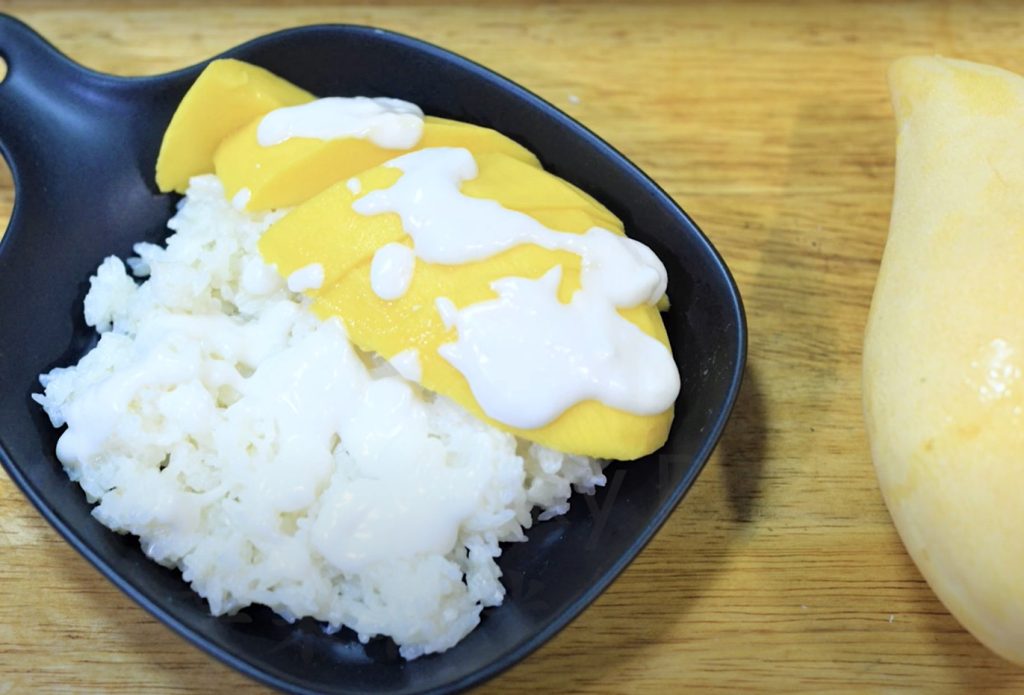
Introduction for Thai mango Sticky Rice
Welcome to the vibrant world of Thai cuisine, where flavors dance and textures delight. Among its treasures lies the enchanting Thai mango sticky rice—a harmonious blend of sweet, creamy coconut, fragrant rice, and luscious mango. Join us on a culinary journey as we reveal the secrets behind crafting this beloved Thai dessert, bringing the essence of Thailand’s tropical paradise right into your kitchen.
Ingredients:
Part A:
- 160g Glutinous Rice/Sweet Rice (Washed and Soaked Overnight)
- 120g Coconut Milk
- 20g Sugar
- 1g Salt
For Part B (Topping Cream):
- 80g Coconut Milk
- 20g Sugar
- 0.5g Salt
- 3g Rice Flour
Part C:
- 2 Ripe Mangoes
Instruction:
- Prepare the Rice:
- Wash and soak the glutinous rice overnight. Drain the water from the rice and steam it for approximately 30 minutes or until cooked through.
- Prepare Coconut Mixture:
- In a saucepan, combine 120g coconut milk, 20g sugar, and 1g salt. Cook the mixture over low heat until the sugar completely dissolves.
- Combine Rice and Coconut Mixture:
- Transfer the steamed glutinous rice to a bowl. Pour the cooked coconut mixture over the rice, mixing it gently until evenly coated. Let it rest for 30 minutes to allow the flavors to meld.
- Prepare Coconut Cream Topping:
- In another saucepan, mix 80g coconut milk, 20g sugar, 0.5g salt, and 3g rice flour. Cook the mixture until it thickens to a creamy consistency. Set it aside.
- Assemble and Serve:
- Slice the ripe mangoes and arrange them alongside the prepared sweet rice. Drizzle the coconut cream topping over the rice and mangoes.
- Enjoy:
- Indulge in the tropical delight of Thai mango sticky rice, savoring the perfect balance of creamy coconut-infused rice and the natural sweetness of ripe mangoes.
Feel free to adjust the recipe steps according to your preference or add any specific instructions that might enhance the cooking experience for your audience. Enjoy the delightful flavors of this iconic Thai dessert!
Video
More Video
Story and History
Thai mango sticky rice, known as “Khao Niew Mamuang,” is a delectable and beloved dessert that embodies the essence of Thailand’s culinary heritage. Its story intertwines centuries-old traditions, cultural significance, and the delightful flavors of coconut, rice, and mango. Let’s delve into the rich history and cultural importance of this iconic Thai delicacy.
Origins and Historical Significance:
The origins of mango sticky rice can be traced back to the lush landscapes of Thailand, where rice cultivation has been central to the country’s agricultural heritage for centuries. Thailand’s tropical climate is conducive to the cultivation of an abundance of mango varieties, contributing to the creation of this dessert.
Historically, glutinous rice has been a staple in Thai cuisine, and the concept of using it in desserts dates back generations. Mango sticky rice emerged as a delicious way to showcase the synergy of ripe, sweet mangoes with the creamy, glutinous rice, complemented by the richness of coconut.
Cultural Significance:
Beyond its culinary appeal, mango sticky rice carries cultural significance in Thailand. It’s often associated with festivals, celebrations, and special occasions, symbolizing abundance, prosperity, and the bounties of nature. Traditionally, it was prepared during the peak mango season, marking a time of joy and festivity.
Moreover, this dessert holds a special place in Thai hospitality, often served to guests as a gesture of warmth and generosity. Its presence on the dining table reflects the abundance of tropical flavors and showcases the host’s generosity towards their visitors.
Craftsmanship and Recipe Evolution:
The crafting of mango sticky rice requires meticulous attention to detail. The rice is soaked, steamed, and then gently mixed with a luscious coconut sauce, allowing the grains to absorb the creamy sweetness. The ripe mango slices are meticulously arranged alongside the rice, enhancing both visual appeal and taste.
Over time, the recipe has seen subtle adaptations, with variations in coconut milk ratios, the addition of pandan leaves for aroma, or tweaks in the rice cooking process. These modifications cater to individual preferences and regional influences while preserving the dessert’s core essence.
Seasonality and Celebration:
The timing of mango sticky rice is intertwined with the ripening of mangoes during Thailand’s summer months, particularly from April to June. During this season, markets burst with vibrant hues of mangoes, signaling the arrival of the dessert’s prime ingredients.
The dessert’s popularity peaks during the annual Thai New Year festival, known as Songkran, where families gather to celebrate and indulge in traditional dishes. Mango sticky rice, with its vibrant colors and refreshing flavors, becomes a staple during these festive gatherings, symbolizing renewal and prosperity.
Global Recognition and Culinary Influence:
Beyond Thailand’s borders, mango sticky rice has gained international recognition, captivating the palates of food enthusiasts worldwide. Thai restaurants globally feature this dessert on their menus, introducing its unique flavors to diverse culinary landscapes.
Its popularity stems not only from its delicious taste but also its gluten-free and dairy-free nature, appealing to a wider audience seeking exotic yet accessible desserts.
Conclusion:
The story of Thai mango sticky rice is a testament to the country’s rich culinary heritage, reflecting the harmony of flavors, the artistry of presentation, and the cultural significance embedded in every spoonful.
As a dessert that embodies the spirit of Thailand’s tropical abundance and culinary finesse, mango sticky rice continues to enchant taste buds, evoke nostalgic memories, and serve as a gateway to experiencing the vibrant and diverse world of Thai cuisine.
